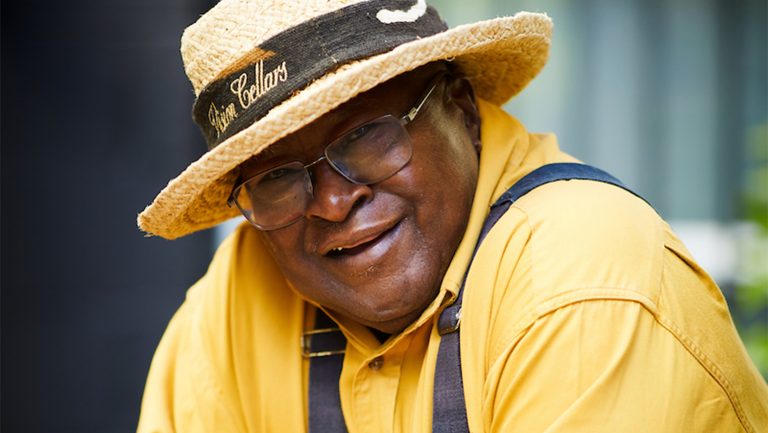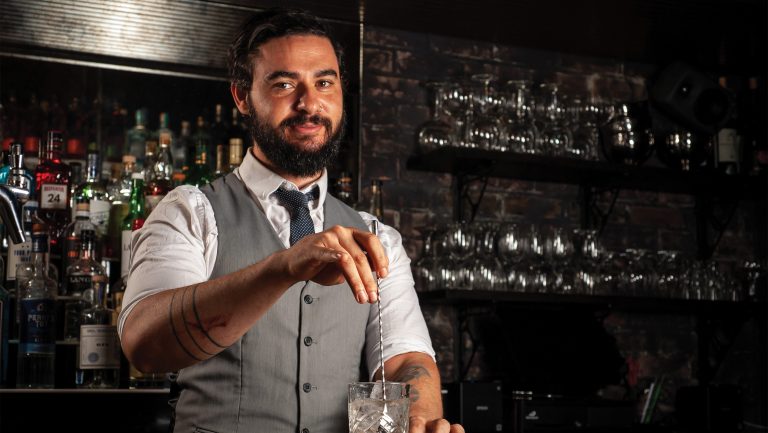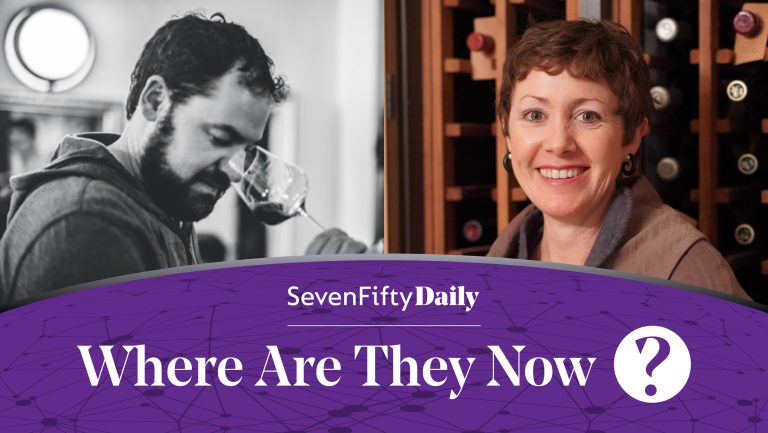Recently, I had dinner with my partner’s uncle, Dan Baron, and he opened a bottle from his new label, Complant. Vinified in Napa, California, from fruit cultivated in the Santa Lucia Highlands of Monterey County, that Pinot Noir was one of the brightest, most lithe California wines I’ve tried. Dan has always been a Cabernet man, and until his retirement in 2017, he was a conventional winemaker in his role at Silver Oak Cellars in Napa’s Oakville. Yet here he is, making low-input, spontaneously fermented Pinot Noir.
What gives? I’ll tell you what: his son, Sam. A graduate of the University of California at Davis Department of Viticulture and Enology, class of 2012, and one of the founders of the upstart Living Wine Collective in Orinda, which created the natural labels Les Lunes Wine and Populis, Sam is now making wine with his father—and the new-generation Davis grad is having a profound effect on the practices of the earlier generation of Davis grad (class of 1978).
That’s just the most intimate example I know of the potentially transformative impact of a particular group of enology students who were all at U.C. Davis in the early 2010s. The crew includes, among others, Les Lunes’ cofounders Diego Roig, Shaunt Oungoulian, and Martha Stoumen, who now makes her eponymous label in Sebastopol; Junichi Fujita, who is establishing a permaculture vineyard in Oregon’s Willamette Valley; Meredith Bell, who works at the Willamette’s Craft Wine Company, where she also produces her own Statera and EST labels; Byron Elmendorf, who cofounded the tiny Clime Wines in the Sierra Nevada Foothills; Napa-based Farella Vineyard winemaker Ryan Pass, whose side projects include Pass Wines, which will have its first release in 2020, and the Basque-influenced Etxea Wines in Napa; and Adrienne Ballou, who is making her own Lightsome Wines while working at Southold Farm and Cellar in Texas Hill Country.

Don’t miss the latest drinks industry news and insights. Sign up for our award-winning newsletters and get insider intel, resources, and trends delivered to your inbox every week.
Together, these young producers are changing the traditional Davis trajectory. Rather than working their way up through the ranks by making conventional wine at brand-name wineries, they’re doing their own thing—producing micro-label, minimalist wines from grapes that, in many cases, they’ve farmed themselves. In the process, they’re upending expectations of natural wines. Using their education to make technically correct, low-input bottles, this group represents an exciting new direction for American wine.
Bucking the Davis Stereotype
The viticulture and enology program at Davis has a 139-year history of educating the winemakers who’ve staffed America’s best-known wineries, predominantly in California. But it’s also faced criticism. For example, in a 2011 column for the San Francisco Chronicle, the wine editor at the time, Jon Bonné, described a visit he made to the viticulture and enology program during which Andrew Waterhouse, then the department chair, asked him why wine writers were so critical of Davis. Bonné, in reply, reported years of talking to winemakers and “repeatedly hearing about how Davis mostly taught by-the-numbers winemaking to help graduates get faceless, rubber-stamped production jobs with Big Wine.”
By the time of Bonné’s visit, however, a cohort of students had coalesced around a different agenda. “The traditional Davis route is you get a job making wine at Cakebread,” says Sam Baron. “There’s nothing wrong with that, but we didn’t want to work at big, established houses.”
This group wanted to experiment, travel, get their hands dirty in the vineyards, and taste all sorts of wines. Some of them, like Stoumen, who grew up in the “hippie enclave” of Sebastopol, came steeped in an ethos of natural foods and farmstead living. Others were working on second careers and had enrolled with an exploratory mind-set. They all developed a desire to make small-batch, unmanipulated wines of their own.
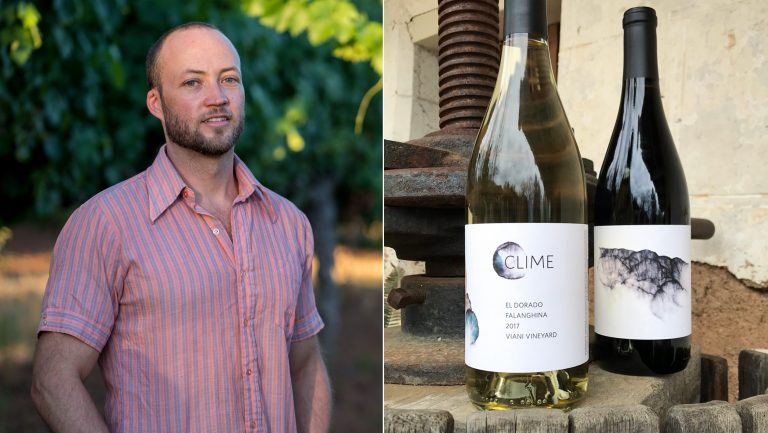
Their approach was a sign of the times, says Clime’s Elmendorf, who earned his master’s degree in 2013. “We [were] living in this craft food and beverage renaissance, so it’s natural that it would make its way to Davis,” he says. “There ended up being a core group of like-minded individuals who influenced each other.”
This was the clique that uncorked old Chinon for Bonné, plied him with questions about macerated whites, and mentioned upcoming internships with maverick producers like Radikon in Italy’s Friuli region. It was this group that led Bonné to declare, in the same 2011 column, that “a new Davis is emerging.”
In retrospect, that’s debatable. Baron says he doesn’t feel his cohort influenced other students. And in fact, he says, “There was a contingent that thought we were really pretentious.” But Baron and his pals were indeed charting their own course at Davis—one that led them to natural winemaking.
“All of us arrived there at a time when we were questioning what we were doing,” says Les Lunes cofounder Roig (M.A., 2012). “‘What if we don’t add sulfur? What if we pick these grapes earlier rather than picking riper and adding acid back?’ As we got deeper, the logical answer was, ‘Why would you take something out to put it back in?’”
Contrary to the stereotype, the Davis professors encouraged these inquiries. Victor Martinez (M.A., 2012) is the co-owner of Ardor Wines, the first natural-wine shop in Portland, Oregon. His 375 labels include those of his Davis chums. “Whether you’re making natural wine or selling it, when people hear you went to Davis, they’re shocked,” he says. “They say, ‘I thought that was the Gallo-making process. What are you guys doing in natural wine?’ We often have to explain that just because you go to Davis, it’s not like you’re indoctrinated. It’s more that you’re learning the science. Professors were like, If you’re smart and asking good questions, you make it interesting for us.” This was the case even when the students were subverting the conventional winemaking norms.
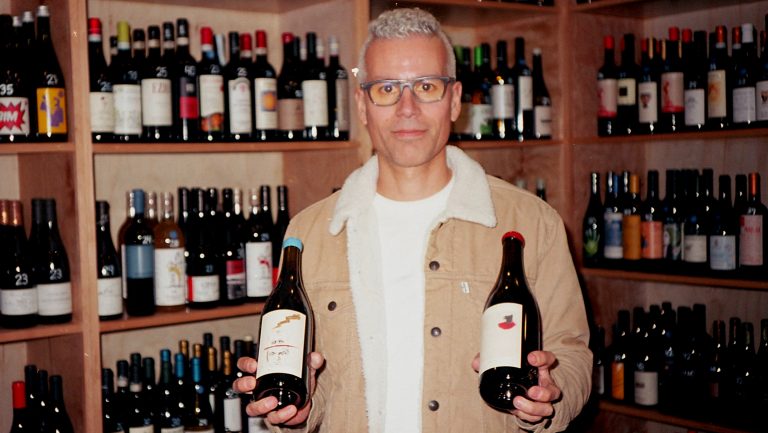
“There were projects funded by the non-natural wine lobby,” says Stoumen (M.A., 2012), “but at the end of the day, the professors were scientists and taught us how you can explore.”
The professors’ openness is something emphasized by this whole cohort of Davis grads. Ballou (B.A., 2012) worked with viticulture professor Andrew Walker on studies, for instance, of hybrids’ resistance to Pierce’s disease. “He was very experimental,” she says. “Being around such creative-minded profs was inspiring.”
Walker, in turn, describes his relationship with these students who were so curious about natural wines as mutually informative. “It was both them beating me over the head and vice versa,” he says, adding that interest in natural winemaking comes and goes among students. “But this was a larger group overall,” he says. “It’s something they can probably hang their hat on.”
Baron says that “the professors realized we were different. I remember Andy Walker telling my dad, ‘This is a special group. They’re exploratory and having fun in a way that’s unusual.’”
The elder Baron attributes much of the positive energy of his son’s cohort to Davis’s state-of-the-art Robert Mondavi Institute of Wine and Food Science, which was funded by California wineries. “They were the first class,” he says, “to make wine in that brand-new facility with professors who, feeling support from the industry, were turned on like firecrackers.”
Tasting the Difference
As faculty members were experiencing their own efflorescence, the students were evolving outside the classroom too. Much of that happened through drinking, as unfamiliar regions, natural wines, and artisan labels started filling U.S retail shelves. The university subsidized a blind-tasting group called Vitus. In 2010, Fujita ran it along with fellow student Dan Blakely, now assistant winemaker at Trefethen Family Vineyards. Fujita, who earned his second bachelor’s at Davis, in 2011, had tasted his first orange wine at a dinner at Manresa, the lauded Bay Area restaurant. The style was just hitting the mainstream, and Fujita was enthralled. “It was my gateway to natural producers,” he says. Inspired by it, he and Blakely hosted an orange-wine tasting.
Les Lunes cofounder Oungoulian ran Vitus the following year, with classmate Bell. “Texture,” he says, “wild flavors wine normally wouldn’t attain—I thought, ‘What else is out there?’” The friends took trips to the Sacramento grocer Corti Brothers, where they picked up Georgian wines, and to the San Francisco wine bar and store Terroir, to taste through the Jura and the Loire.
“We got pushback from students who wanted conventional wines,” says Stoumen, “but we had a limited amount of time, and this is what we wanted to drink.’”
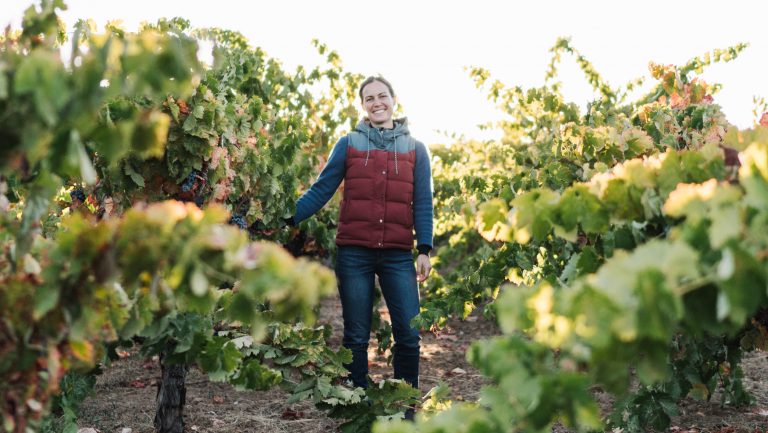
Tasting shaped the group’s aspirations. “I remember,” says Ballou, “[that] Martha and Diego brought a bottle of COS one night.” The biodynamic Sicilian wine provided her an aha moment. “I thought, ‘This is so fascinating, I want to pursue this kind of winemaking.’”
Embracing Science
Ironically, it was the U.C. Davis program’s emphasis on science that helped Ballou and her peers fulfill their dreams. “There’s this idea with natural winemaking that it’s just intuition,” she says, “but there’s also a lot of science behind it, and that’s what we learned at Davis.”
Using a spectrophotometer to analyze sugar content during malolactic fermentation so that you know which barrels to stir or warm to avoid the volatile acidity that leads to vinegary flavors; learning how to inactivate bacteria that might otherwise feast on amino acids in the lees and turn your wine mousy; going back to the textbooks to develop a viticulture plan for a region with a shorter ripening season so you can achieve phenolic ripeness without acidifying—these young winemakers give countless examples of how science improves natural winemaking.
It’s a Davis approach to an anti-Davis style, explains Oungoulian, “a way to make vibrant, zero-additive, nonfiltered wines from biodynamic vineyards that are consistent and stable.” In natural winemaking today, it’s another distinguishing feature that makes this crew mavericks.
“I feel like a lot of natural producers have gotten away from those scientific learnings,” says Fujita, and that leaves them few tools to avoid “volatile wines, ones ridden with brett aromas, murky, and re-fermenting in bottle.” These are the wines that have “caused the backlash” against natural production, he argues. “They start to taste the same because they’re riddled with the same faults.”
Of course, some people like a bretty or lacto quality. “There are people who are into natural wine [who are] seeking those off flavors,” says Martinez. “Taste is taste, and at Ardor, I have wines that appeal to them.” But given his education, “it’s not like I don’t know what caused those flavors.”
Out in the World
If they were ever skeptical about the synergy between science and natural winemaking, this group’s many apprenticeships set them straight. Most of those stages were in Europe. “We’d talk to people in California about low-intervention wines,” says Oungoulian, “and most said it’s too risky. So the solution was to go experience it under people who’d been doing it for generations.”
One of Oungoulian’s stages was with Julie Balagny, who had left the Rhône’s biodynamic Terre des Chardons to start her own project in Fleurie. There, another natural producer, Jean-Claude Chanudet, hosted a weekly soirée de microscope at his winery, Domaine Joseph Chamonard. “A microbiologist would come with a microscope,” says Oungoulian. “Guy Breton, Jean Foillard, Jean-Claude Lapalu, Jean-Louis Dutraive, the Lapierre kids—a lot of the known natural winemakers in Beaujolais—would come and examine yeast and bacteria. Being from Davis, I had the chops to hang with them. It was cool seeing that the people making natural wines I loved were some of the most precise, knowledgeable people.”
After graduating, Fujita worked under the legendary Jura winemaker Pierre Overnoy, who, he says, “is able to make wines with no sulfur, filtration, or fining because he has respect for science.” Fujita traveled to Tasmania, too, to learn the principles of integrated ecological design on permaculturalist Bill Mollison’s farm.
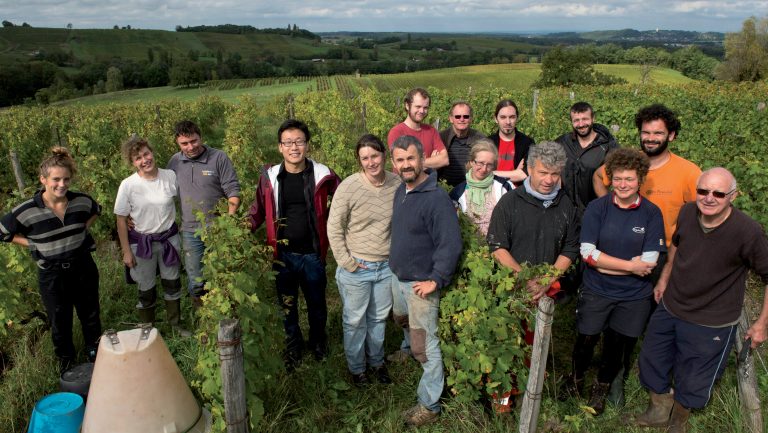
Baron and Bell both went to Burgundy. On weekends, the friends would visit producers. “It turned into this game,” says Bell. “How can we get ahold of these winemakers that we want to talk to? Many don’t have websites or phone numbers. You go to taste, and they don’t have wine to sell. It’s the opposite of America. Michel LaFarge, Jean-Marie Raveneau—we managed to see 50-plus producers in a couple of months. We were on a mission to meet these incredible, iconic winemakers who were making wine completely differently than most Americans.”
Says Stoumen, who counts Giusto Occhipinti, of Sicily’s celebrated Azienda Agricola COS, as a mentor, “I know winemakers who are getting into natural wine, but they haven’t worked for natural winemakers in France and Italy, so you get more of a mixed bag. For our cohort, it was a given that we were going to learn from these people first.” Roig and Stoumen ran cattle and pigs through the vineyards at Domaine Léon Barral in Languedoc and pitched in for harvest at biodynamic Seresin Estate in New Zealand.
Becoming Grower-Vintners
The farming apprenticeships were crucial, says Oungoulian. “If you’re not adding stuff in the winery, it’s so helpful to have well-farmed grapes.” U.C. Davis put more emphasis on winemaking than viticulture, and despite the faculty’s best intentions, there was little training in organic farming. Says U.C. Davis’s Walker, “We’ve been trying to put an organic block in for years, but the campus has not followed through.” To learn more during summer breaks and after graduating, Oungoulian and his friends “felt compelled to leave the U.S.”
Fujita returned from postgraduate work abroad with a mission: “Biodynamic farming, environmental issues, climate change, sustainability—they came together as my focus.” On the 30 acres he acquired with family support in Oregon’s McMinnville AVA, he uses minimal tillage, no chemicals, and a permaculture design. Part of his approach is to plant “a traditional Burgundian diversity”—Pinot Gris, Aligoté, Gamay, many Pinot Noir clones—to help handle climate change. “We’re going to face more issues, like freak frosts,” he says. “In years that are too hot or cold, the accessory grapes might bring balance.”

Bell puts sweat equity into the Willamette vineyard that grows her grapes. And the pushback Roig and Oungoulian once got from landowners has subsided as they’ve proven that they can farm organically. Today, the two partners work 20 acres and are poised to take over another 10 in Napa and Sonoma. Both Pass and Elmendorf buy organic Merlot grapes from them.
Elmendorf, who was a climate change consultant before attending Davis, isn’t currently growing grapes, but he’s collaborating with other winemakers to persuade bigger growers in the Sierra Foothills AVA, where he lives, to farm sustainably. “We don’t have the money of other regions, but that’s not an excuse anymore,” he says. “The customer demands it, and it’s the right thing to do.”
With their focus on eco-friendly farming, Walker’s former students are poised to help the industry weather environmental pressures. “I think they’re going to be doctors of new and better adapted varieties more rapidly than others,” says Walker. “It’s good to have someone looking forward to climate change and how to better address it with better plant material.”
The willingness of this new generation to think outside the box also holds promise for their ability to build sustainable winemaking careers. The eight leased acres Stoumen is converting to organics in Ukiah in Mendocino County comprise long-held family farms. The mutually supportive style she acquired with her pals at Davis is informing the way she works with these landowners and others. “What’s the succession plan for all of these older farmers?” she asks. “A lot are retiring. I can’t buy these huge ranches, but there has been talk with other young winemakers about what we can do to maintain this fruit source. I feel the future is collaborative.”
Coming Into Their Own
Collaboration isn’t easy. In 2013, Sam Baron was one of four friends who started the Living Wine Collective and launched the Les Lunes and Populis labels. Their wines, made from vineyard finds like old Carignan from Ukiah and own-rooted Chardonnay from Mount Lassen, were a hit at wine-driven Bay Area restaurants. But the partnership dissolved, and he and Stoumen moved on. “It’s hard,” he says, “to have four winemakers and no accountant.”
Still, their initiative inspired their peers. Ballou released her own label, Lightsome Wine, in 2017 with one barrel vinified from Texas High Plains grapes. Whole-cluster and spontaneously fermented with minimal sulfur, her Mourvèdre is light-bodied and zippy. Texas Monthly featured it among the state’s top 50 wines to drink last fall. “I don’t think I would have thought about doing it this early on in the game,” she says, “if it weren’t for seeing Shaunt, Diego, Sam, and Martha do it.”
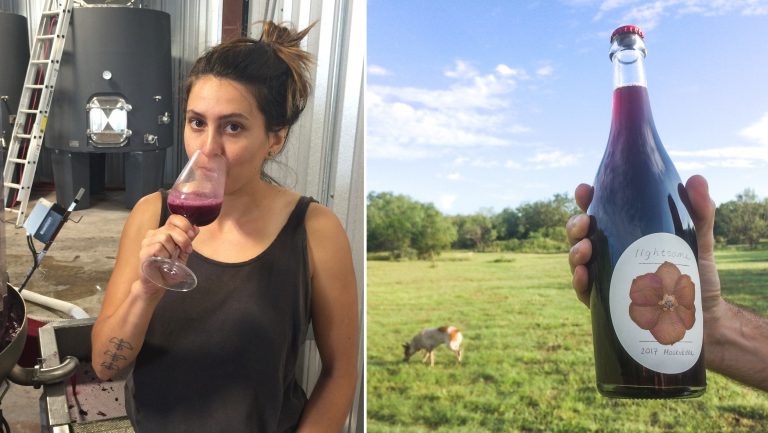
Ballou also holds down a full-time job at the bigger Southold Farm and Cellar. That’s the financial reality for many young winemakers today. But these friends’ melding of science and natural wine makes them uniquely employable in a certain niche of the wine world. Bell, for example, was just the assistant that Chad Stock needed for his Minimus label at Craft Wine Company in Carlton, Oregon. “In the case of natural wine, in particular, it’s important to understand chemistry, pH, sanitation, and stuff,” says Stock. “It’s difficult to find that person with that combination of interest and skills.”
Though some employers might be threatened by an assistant’s side project, forward thinkers like Stock welcome such initiative. “It made Chad more attracted to me because you know what’s on the line if you’re doing it yourself,” says Bell. Partially whole-cluster, with no additions save for a bit of sulfur, her EST Pinot Noir is super fresh and vibrant. She’s also the first winemaker in the Willamette Valley to produce a Chardonnay-only label—Statera.
Bell’s friends, too, are breaking molds. At Pass Wines, Pass dives deep into reductive winemaking. “How much oxygen can you put into a Chardonnay during fermentation before it becomes too oxidized?” he asks. “In Napa, you have to play it safe because fruit is so expensive. The winemakers I was working with out of college were unwilling to take risks, so I wanted to do it myself.”
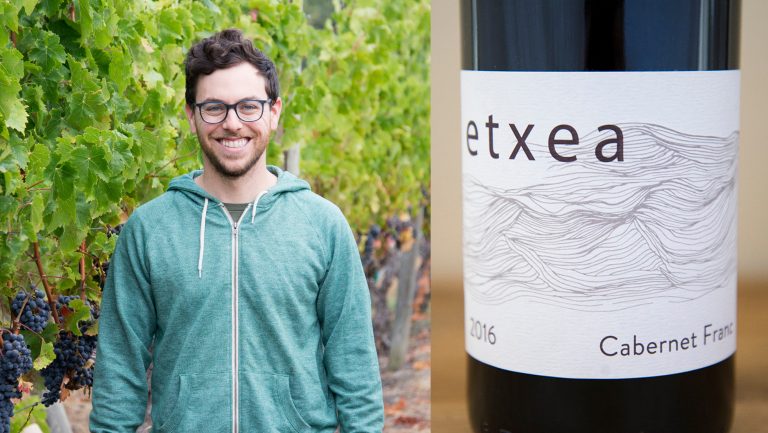
Fujita’s release this year will be a flor-influenced sparkling Pinot Noir. Stoumen’s Teal Drops Rosé, barrel-aged on the lees for a year, is like a bright, saline rehabilitation of white Zinfandel. “The response was more amazing than I could’ve imagined,” says Stoumen, who quickly sold out her first release of sparkling wines and reds in 2017.
For Roig and Oungoulian, who still make Les Lunes in Oungoulian’s parents’ Orinda basement, the ultimate sign of their success is the accolades from their French mentors. “Eric Texier tried our wines and was super excited,” says Oungoulian. “Athénaïs de Béru of Château de Béru was very complimentary of our Chardonnay, which meant a lot to me coming from such an amazing 10th-generation Chablis producer.”
They couldn’t have done it without help from their friends. Sharing distributor contacts, pouring each other’s wines on restaurant calls, swapping notes on enology, viticulture, and business, the winemakers “absolutely support each other,” says Oungoulian. “We’re collectively pushing for the same thing.”
That shared mission, in a nutshell, is “to find new ways to farm and vinify, and a new voice for our generation,” says Fujita. “I’m so happy that my friends are also passionate about natural wines with minimal intervention—but based on their technical foundations. That is the way forward.”

Dispatch
Sign up for our award-winning newsletter
Don’t miss the latest drinks industry news and insights—delivered to your inbox every week.
Betsy Andrews is an award-winning journalist and poet. Her latest book is Crowded. Her writing can be found at betsyandrews.contently.com.




